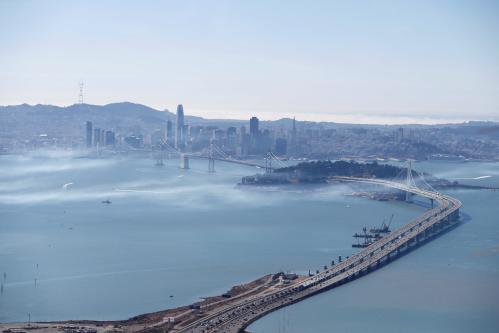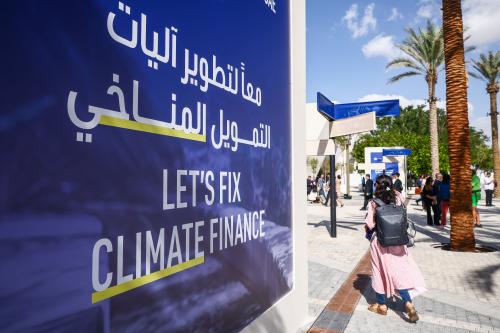When the green elite trumpet their policies at the Global Climate Action Summit this week, a more important question must be pressed, write David Victor and Veerabhadran Ramanathan: What are they doing to get others to follow their lead? This piece originally appeared on The Hill.
San Francisco has the potential to catalyze a new, more effective strategy for tackling the causes and consequences of a changing climate.
This week San Francisco will host a climate summit—but unlike most official global forums, California Gov. Jerry Brown (D), the event host, has invited only the players who are actually getting things done. There are mayors, heads of state, corporate chiefs and other icons who share common ground on practical solutions. By showing the way, others can do the same.
For decades attempts to forge global cooperation have stalled, in part, because they relied on global summits where all nations were expected to agree. That never happened in any meaningful way. This new approach, which relies on leaders mainly within nations, is much more decentralized and flexible.
For all the hope in this new approach, some stark realities of climate science still loom large. One is that the leaders are good at celebrating themselves, but they still account for a tiny fraction of global emissions. California, for example, in spite of the fact that it is the sixth largest economy in the world, accounts for less than 1 percent of world emissions. Ironically, the more the leaders lead the less relevant they become to the overall ledger of pollution.
When the green elite trumpet their policies this week, a more important question must be pressed: What are they doing to get others to follow their lead?
What harms the planet is the global mixing of pollution from carbon, methane and other warming gases. The atmosphere cares little if the hyper green get clean while the overall picture is still dirty. A new study by Yale University, the NewClimate Institute and the Netherlands Environmental Assessment Agency has assessed 6,000 of these elite green activities and found that they will lower global emissions over the next decade or so only about 3 percent.
To be sure, some of these efforts are extremely ambitious. The Under 2 MOU coalition of 206 cities, states and countries, initiated by Brown, spans governments that represent 1.3 billion people and nearly 40 percent of the global economy. It outlines visions for bold climate actions towards deep decarbonization consistent with the Paris goal of limiting the warming to well below 2 degrees Celsius.
The problem of green elitism is easy to fix, but it will require more than just self-congratulation at global summits. Leaders must become much more transparent about the experiments they are running as they learn how to cut emissions.
For decades, it has been assumed that climate policy would be hard to implement because it is expensive. While that is true—climate protection is worth the money, but not free—an equally daunting obstacle is the lack of information about how to make profoundly deep cuts in emissions. Deep decarbonization is a journey with known goals and unknown steps.
The San Francisco greens are now generating some of the insights needed to map the road for deep decarbonization. They are learning, as in Hawaii, how to integrate massive amounts of renewable power on the grid; in China, they are learning how to expand infrastructures for electric vehicles.
These insights are generating not just ideas but also verifiable reductions in emissions. Today, 32 percent of California’s electricity comes from renewables with essentially zero emissions; new legislation puts the goal at 60 percent by 2030 and will push higher in the years beyond. The shift to renewables, along with a host of other policies, explain why California’s emissions have declined 9 percent over the last decade while its economy grew nearly by half and the population rose 16 percent.
Like essentially all major economies, California has found it hardest to tame emissions from transportation. A big push in electric vehicles powered by an ever-cleaner electric grid will bend down emissions and could offer models for the rest of the world. About half the nation’s electric vehicles are sold in California, thanks to aggressive incentives and a program to build a network of charging stations.
What needs to be done better is to spread the word—about what works and fails—in ways that make it easier for others to pick up the lessons from these living laboratories.
For all the promise in leadership, so long has passed without serious global actions on climate change that big doses of warming are all but inevitable. In the early 1990s, when the climate issue was first reliably on the global political agenda, a plan to cut emissions over decades—modestly at first, then quickly—would be bearing fruit by now. That didn’t happen, and with delay the cuts needed to stop warming have multiplied. It is possible that even cutting global emissions essentially to zero won’t be enough because most of the pollutants that cause warming are long-lived in the atmosphere. The full effects of swift action to cut emissions filter though the climate system over decades or longer.
Climate leaders, particularly those in San Francisco, have a lot to offer on this front. The leaders have done the most to demonstrate how to make deep cuts in short-lived “super-pollutants.” Examples include soot, which comes from diesel engines, primitive cookstoves, and a host of other sources, along with methane and a slew of potent industrial gases. Careful spadework by firms and some environmental groups have assessed how to cut a big source of methane leaks—from oil and gas drilling and piping. Others have charted cuts in soot, which is particularly promising because lowered soot helps the climate and is also a major benefit for human health.
A lot more work is still needed, including on technologies that can scrub carbon dioxide directly from the air. Current estimates are that perhaps as much as 500 to 1,000 billion tons of carbon dioxide have to be captured by 2100 to avoid catastrophic climate disruption.
While the politics of climate action keep grinding on, governments must make much bigger efforts to manage climate impacts.
It took nearly three decades for all the talk about global warming to inspire today’s level of action—fragmented, diffused, inadequate as it is. Let’s not let the same long period lapse before waking up to all the impacts. Avoiding catastrophic changes in the climate is a race against time and inaction; it is a race that must be won.





Commentary
Turning California’s green leadership into a green planet
September 10, 2018